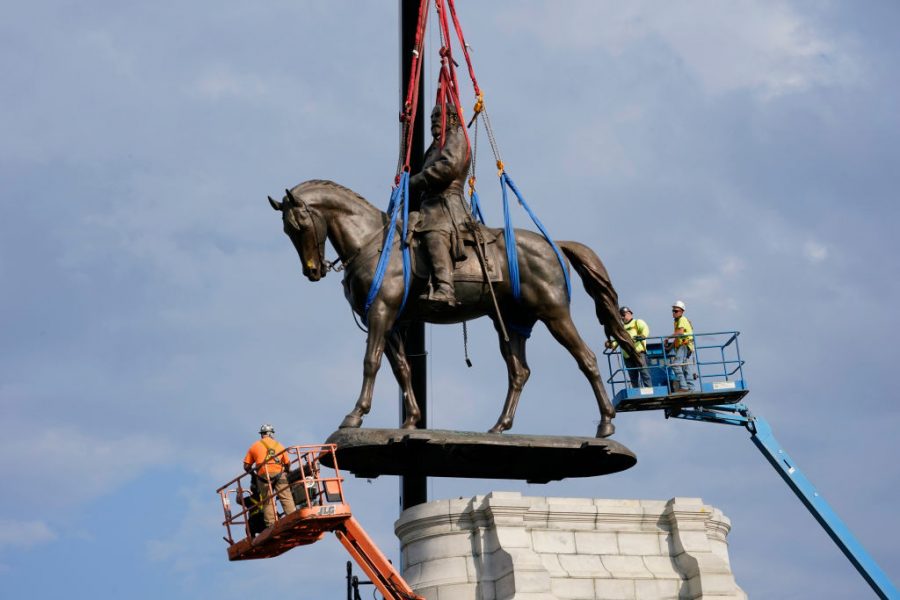Biggest Confederate Statue Removed From It’s Pedestal in Richmond, VA
RICHMOND, VIRGINIA – SEPTEMBER 08: Crews remove a statue of Confederate General Robert E. Lee on Monument Avenue, September 8, 2021 in Richmond, Virginia. The Commonwealth of Virginia is removing the largest Confederate statue remaining in the U.S. following authorization by all three branches of state government, including a unanimous decision by the Supreme Court of Virginia. (Photo by Steve Helber – Pool/Getty Images)
September 24, 2021
On September 8, 2021, workers in Richmond, Virginia removed its statue of Robert E. Lee. Once removed, the statue was split into two, ending its 131 year reign as the state’s biggest Confederate statue.
The crowd watched with astonishment as the workers fixed slings onto the statue and waved at the crowd to cheer. One of the workers held up their hand. Five, four, three, two, one. The statue was lifted from its base. The crowd sang, “hey, hey, hey, goodbye,” at the top of their lungs.
/cloudfront-us-east-1.images.arcpublishing.com/gray/HGNEX7TK65AJXGZVYCQT5G37VE.jpg)
Robert E. Lee was known as a Confederate general who led a secession during the Civil War. According to The New York Times, Lee was a slave owner and considered himself a “paternalistic master,” who could “impose severe punishments…especially to those who r[a]n away.” During the invasion of Pennsylvania, Lee’s forces enslaved free black Americans and brought them to the South. By the time the Civil War ended, Lee had become the embodiment of the Confederacy in the South. A newspaper in 1890 called Lee “the possession of the American people.” Right after the statue was removed, former President Trump had characterized Lee as a “unifier” and a “premeir war strategist.”
In reality, according to CNN, Lee had “poor maps and an unprepared staff,” and he had created problems of his own. Joseph Glatthaar, who wrote numerous books on the military, wrote “what Lee achieved in boldness of plan and combat aggressiveness diminished through ineffective command and control.”
Governor Ralph Northam and Rita Davis, the governor’s top legal counsel who formulated the legal plan that would allow for the removal of the 12-ton, 21-foot-high statue, along with other state officials, watched as the statue was ripped from its pedestal.
“I was probably 90% sure we were going to get here,” said Davis. A group of residents had filed a lawsuit to protect the state. However, the Supreme Court of Virginia rejected their appeal and cleared the way for its removal.
“Now I believe it. It is wonderful to see,” said Davis. “I wish the people who came before me and paved the way for me could see this. Ultimately, goodness prevailed.”
Melody Barnes, former aide and chief counsel to Senator Edward M Kennedy, noted that this statue “went more quietly than the others did.”
Once the statue was on the ground, workers sawed off the torso and placed the statue in a truck where it would be pulled away.
“I just keep thinking about when this statue went up, John Mitchell said… it’ll be a Black man who takes it down,” State Senator Jennifer L. McClellan referred to a legendary Jim Crow newspaper. “Then I saw a contractor take a picture of it,” she said, gesturing to Devon Henry, “I think the healing can begin.”



